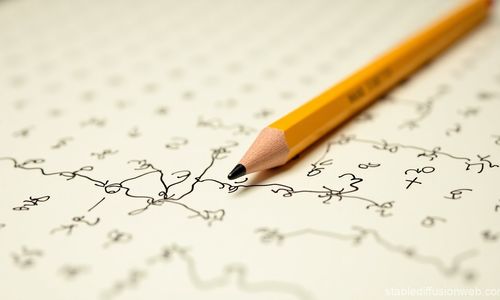The history of the pencil starts with a violent thunderstorm. When some particularly ferocious weather struck the Lake District in North West England in the sixteenth century, locals in the village of Borrowdale discovered a large uprooted tree. Underneath the tree lay an unknown black substance which we now easily, was slightly shiny and smooth to the touch. And it left a black smear on the hands of all who touched it.
Initially, the local farmers used the newly discovered material as a handy way to identify their sheep. However, others quickly realised the potential for using this intriguing substance to write on paper. When it was untreated the material was very soft, which meant that it was messy to handle. To make it fit for use with paper, people enclosed a thin core of the substance in stiff sheep hides or rope. At this time chemistry was still in its infancy. People searched for a word to describe this increasingly useful substance and came up with plumbago which, in Latin, means acts or writes like lead. Later the name was changed to graphite. But because words have remarkable staying power, we still call graphite the lead of a pencil even though it is now known that there is no trace of real lead in graphite.
Graphite has a very high melting point at around 3,500 degrees Celsius. This made it invaluable to the British army and navy as a secret ingredient in the manufacture of cannon balls. The Royal Ordnance, or weaponry section of the British armed forces, used graphite as a lining inside the moulds for cannon balls, which as a result the British could turn out faster and more cheaply than their European rivals. In addition to its value to the armed forces, the government quickly realised the commercial potential of the graphite at Borrowdale, and assumed control of all the mines there during the sixteenth century. Armed guards accompanied the precious graphite all the way down to the metal foundries by the naval shipyards in the south of England. The graphite was so valuable that the locals, who called it wadd, started to steal it. As a deterrent, an act of parliament in 1752 made this offence punishable by time in prison.
The Italians originally invented the wooden casing to hold a thin rod of plumbago firmly in place for ease of writing. Italian craftsmen hollowed out two small sections of cedar wood, into one of which they laid the lead. They then glued the other section over the top and left the two halves to set. When dry, the whole apparatus formed what today we know as a pencil. The Germans took this technique and developed it further by applying mass-production techniques to pencils. At the same time Nicolas-Jacques Conte, a French officer in Napoleon Bonaparte’s army during the late 1700s, developed a method of mixing powdered graphite and clay together for firming in a kiln. Adding more clay to the mixture helped make the pencil harder, sharper, and more precise in its mark. More graphite helped make a pencil mark that was softer, thicker and darker.
The varying quality of pencil leads eventually gave rise to a system for categorizing the fineness of the pencil mark. Pencil manufacturers all over the world still use this so-called HB grading system today. The H stands for the Hardness of the pencil while the B stands for its Blackness. An HB pencil is a standard pencil and a variety of letters and numbers are used to designate different types of lead.
Significant seams of graphite exist in parts of China, which now produces most of the world's pencils. Interestingly, the Borrowdale mine in the Lake District remains the only significant source of graphite in its near-pure form in the world. Nowadays the highest grade of graphite at Borrowdale is totally exhausted, although other grades can still be found, and England's pencil industry continues to thrive in the nearby town of Keswick.
The pencil has turned out to be a remarkably resilient and valuable tool whose use has survived well into our high-tech times, as a well-known story shows. It is sometimes said that the American space programme spent millions of dollars to invent a pen capable of writing in the zero gravity of space. The Russians, by contrast, simply equipped their astronauts with good old-fashioned pencils that never let them down. It should be pointed out though, that the popular myth about Americans overlooking the practical advantages of pencils in zero gravity is merely fiction. In actual fact, both American and Russian astronauts were equipped with pencils in their respective country’s first space flights. A private company later developed pens for writing in zero gravity. In fact, astronauts of every nation now use pens. But no matter - pencils remain in use in every classroom, every planning, building and drawing office, and in every art studio in the world. And there is nothing to suggest that we are likely to invent anything better than graphite to use in our pencils.
